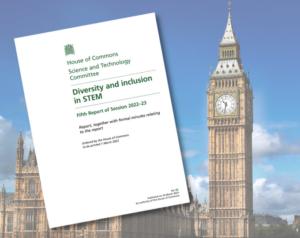
Report, together with formal minutes relating
to the report – Ordered by the House of Commons – to be printed 1 March 2023
The UK House of Commons Science and Technology Committee has published recommendations to government on how to address Diversity and inclusion in STEM.
The Science and Technology Committee launched their inquiry into diversity and inclusion in STEM on 22 November 2021, to explore the situation for women, people from certain ethnic backgrounds, people with disabilities, those from disadvantaged socio-economic backgrounds and those who declared themselves as being LGBTQ+ in STEM education, STEM research and STEM employment. They received and published over 100 written submissions and took oral evidence from 32 individuals, including representatives from under-represented groups, school leaders, the UK research ecosystem, the then Minister for Equalities, Kemi Badenoch MP, the Minister for Science, Research and Innovation, George Freeman MP, and the then Minister of State for School Standards, Robin Walker MP.
Aims of this Report
Although they received a great many contributions, by their nature Reports such this offer a snapshot of particular situations at particular moments; and they do not claim to have produced the last word, or an exhaustive research exercise, on diversity and inclusion in all STEM education, research or workplace settings. Instead the report sets out the evidence they received regarding certain areas of STEM education in schools, research and employment, and ask what policies could be utilised to respond to under-representation where it exists. Specifically:
- In Chapter 2 they consider the nature and extent of under-representation in STEM settings, and what data is currently available.
- In Chapter 3 they focus on STEM education in schools, and the uptake and attainment trends among certain groups in STEM subject cohorts. We examine the importance of the curriculum, the teaching workforce, and what has been done by the Government. We also make recommendations for action that should be taken to address identified problems.
- Finally, in Chapter 4 they turn to the STEM workforce, primarily in research facilities but also in other employment settings.

 Print This Post
Print This Post





